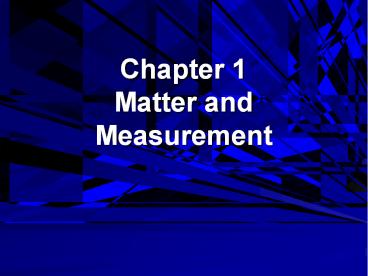Chapter 1 Matter and Measurement - PowerPoint PPT Presentation
Title:
Chapter 1 Matter and Measurement
Description:
Chapter 1 Matter and Measurement – PowerPoint PPT presentation
Number of Views:309
Avg rating:3.0/5.0
Title: Chapter 1 Matter and Measurement
1
Chapter 1Matter and Measurement
2
What is Chemistry?
- The study of all substances and the changes that
they can undergo - The CENTRAL SCIENCE
3
Why Study Chemistry?
- Useful for other sciences
- Required course ?
- Fun and Challenging
- Remember
- Process of Discovery
- Understand Concepts, NOT Single Facts
4
Scientific Method
Observation
Question
Hypothesis
Experiment
Conclusion
5
Scientific Method
Conclusion
- Natural Law
- Explains how nature behaves
- Theory
- Explains why nature behaves in a certain way
Prediction
Experiment
6
Liquids
7
Liquids
- Definite
- Molecules
- Not affected by
8
Solids
9
Solids
- Dont
- Definite
- Molecules
- Not affected by
10
Gases
- Low
- Density
- Expands to
- Indefinite
- Molecules move
11
The Metric SystemThe International System of
Units
- Standards of measurement
- Base units (7) Fig 1-14 p. 18
- MASS
- LENGTH
- TIME
- COUNT, QUANTITY
- TEMPERATURE
- ELECTRIC CURRENT
- LUMINOUS INTENSITY
12
The Metric System
- Derived Units
- AREA
- VOLUME
- ENERGY
- FORCE
- PRESSURE
- POWER
- VOLTAGE
- FREQUENCY
- ELECTRIC CHARGE
13
The Metric System
- Metric Prefixes make base unit larger or
smaller - Based on 10
- Math method vs. Stairs
14
Conversion Practice
- Convert a volume of 12 microliters into
centiliters - Express a distance of 15 meters in kilometers
- Convert 83 cm into meters
- Which is the longer amount of time, 1351 ps or
1.2 ns? - Convert 16 dL into L
15
Types of Measurements
- Mass amount of
- Expressed in
- Does not
- Weight
- Expressed in
- Changes with
16
Types of Measurements
- Volume the amount of
- Many instruments to measure
- Temperature
- Degrees
- Degress
17
Density
- Common ratio used in chemistry
- Physical property of a substance
- SI units
- Solid
- Liquid
- Gas
Can change due to temperature and/or pressure
changes
18
Density
- Find the density of a piece of metal with a
volume of 2.7 cm3 and a mass of 10.8 g.
2. Determine the mass of an object with a density
of 0.24 g/cm3 and a volume of 2 cm3.
19
Uncertainty in Measurement
- Why are digits in measurements uncertain?
- Instruments never completely free of flaws
- Always involves estimation
- Choose the right instrument for the job
- May be estimated for you (electronic scales)
- Scale is marked but you estimate the in-between
20
Uncertainty in Measurement
- Precision
- Accuracy
21
Significant Digits
- All digits known with certainty plus one final
digit which is uncertain (or estimated) - All non-zeros are
- A zero is significant when
- It is
- It is
- A zero is not significant when
- It is
- It is
22
Significant Digits - PRACTICE
- How many significant digits?
- 54.23
- 23.00005
- 0.0004
- 35000
- 0.000504
- 45.623200
- 5,000,000
- 4,000,000.1
23
Significant Digits - Calculations
- Addition and Subtraction
- 1.21 5.002 10. 16.212 becomes 16
- 34.5 12.45 23.0505
- 186.31 11.1
- 12.0231 3.86
- 0.100012 120.
- 1200 12 15 0.5
24
Significant Digits - Calculations
- Multiplication and Division
- The answer has as many sig figs as the number
with the fewest sig figs - 14.8 x 3.1 45.88 becomes 46
- 18.2 x 3.0
- 52/1.5
- 321.868783 x 1
- 2400 x 2.123
- 15000/12.354
25
Scientific Notation
- Convenient way of writing very large or very
small numbers and showing only significant
figures - Number between 1 10 with a power of ten
- 5120 becomes 5.12 x 103
- Move decimal point in original number to make
number 1-10 - Move left move right -
26
Scientific Notation Practice
- 123,000
- 0.000045
- 23.45
- 0.0000000003
- 1,000,000
27
Scientific Notation
- Adding and subtracting
- Multiply and divide
3.38 x 103
28
Conversion Factors
- Enable movement between metric system and
English system - See back cover of book and Appendix III
- Common conversions you should memorize
- 1 inch 2.54 cm
- 1 mile 1.609 km
- 1 kg 2.20 pounds
- 1 mL 1 cm3
- 0 K -273.15 0C
- 0F 1.8(0C) 32
29
Dimensional Analysis(Problem Solving)
- Remember ALWAYS use UNITS OF MEASUREMENT in
your work!!! - A technique of converting between units
- Same system (metrics)
- Different systems (inches to meters)
- Chemical equations.later chapters
30
Dimensional Analysis(Problem Solving)
- Conversion Factors ratio derived from the
equality between 2 different units - CF can be written either way
31
Dimensional Analysis(Problem Solving)
- The t method
Conversion Factor
Example How many liters are in 125.6 gallons?
32
Dimensional Analysis(Problem Solving)
Dimensional Analysis(Problem Solving)
How many seconds are in 4.15 hours?
If a student needs 1.5 mL of water, how many cups
does he need?































